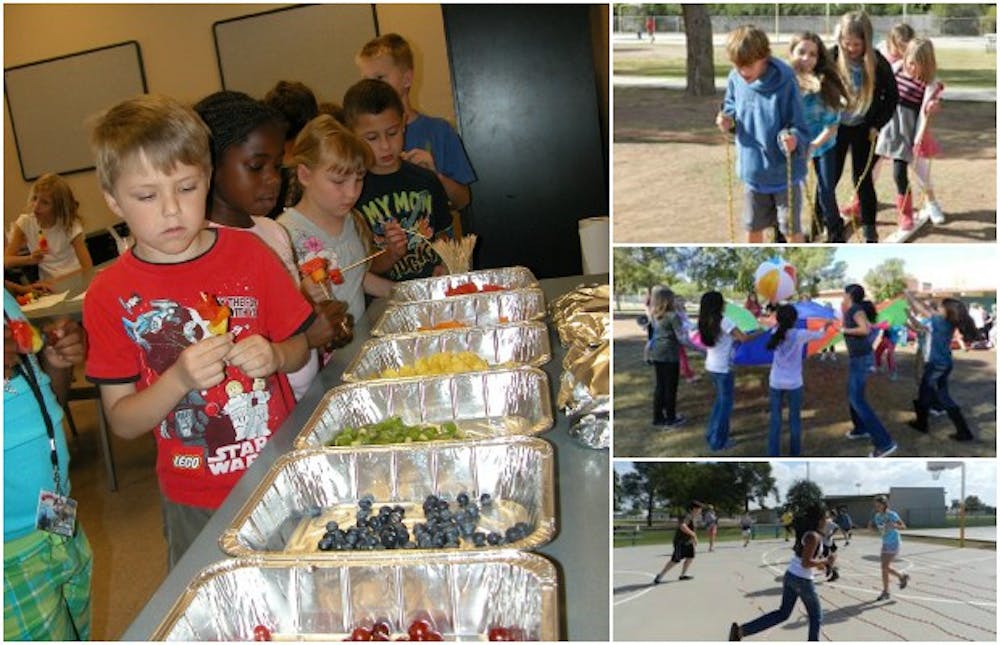 As the youth obesity rate rises, 18 ASU students volunteer at the ASU Prepatory Academy with the Mollen Foundation to try to combat the recent epidemic.
As the youth obesity rate rises, 18 ASU students volunteer at the ASU Prepatory Academy with the Mollen Foundation to try to combat the recent epidemic.Photos courtesy of the Mollen Foundation
Ask any elementary school student what their favorite subject is. Chances are the answer will be recess.
Images of freeze tag, red rover and a variety of other playground games might come to mind, but something has changed. In just one generation the rate of childhood obesity has nearly tripled, according to statistics from the Centers for Disease Control and Prevention (CDC).
Eighteen Arizona State University students are spending their mornings at the ASU Preparatory Academy and other local schools, volunteering with the Mollen Foundation.
The Mollen Foundation, a local nonprofit, goes into schools and does a complete health intervention with students and faculty. The foundation aims to prevent childhood obesity through education.
“Our goal is to leave the faculty with a self-sufficient wellness program that they can continue,” says Jodi Heidbreder, the Mollen Foundation director.
Volunteers design interventions to fit the particular needs of each school. They begin by assessing students’ attitudes towards health and fitness with a self-report survey. Past interventions have shown promising results: 90 percent of students reported at least one positive behavioral change.
Almost all of the Mollen Foundation’s volunteers are ASU students studying to work in the health field. Volunteers create fitness and nutrition programs to generate a culture of health awareness in schools.
“It is great hands-on experience for them,” Heidbreder says.
The Mollen Foundation partners with two to four schools at a time to make the health intervention part of the school day. The foundation will work with a school for up to two years. On average the foundation reaches 1,500 students, Heidbreder says.
Dietetics junior Cami Ligon visits ASU Preparatory Academy three times a week to teach the ins and outs of fitness to students in kindergarten through 5th grade. She has been volunteering with the foundation since early October.
“I do different fitness programs for each age group,” Ligon says. “Lately I’ve been doing jump rope activities with a group of young girls because they love it. I include nutrition education into jump rope songs.”
Ligon says motivating students she works with to be active sounds easier than what it really is.
“To get the kids involved in something, you cant’ force them to do it,” she says. “They have to think the activity is fun.”
Many children do not get the recommended 60 minutes of physical activity per day even with recess and traditional physical education, according to facts from the CDC. Ligon says she tries to get each student involved in activities that interest them.
“The whole point is to get them to be active because they want to be, not because they have to be,” she says.
Ligon says she thinks physical education falls short in staffing. She says the foundation helps by providing a higher ration of staff to students.
“We can find activities for each age group or gender, anything to get the kids excited about moving,” she says.
After Ligon is finished implementing her fitness program at ASU Preparatory Academy, she says she hopes the facility will continue to apply her interactive style to physical education.
“Actually be involved with them, if they are playing soccer then go play with them and not just coach them because they respond to that,” she says.
A health intervention also involves a nutrition component. Mollen Foundation volunteers teach students what it means to eat healthy in a hands-on classroom setting.
“If these kids aren’t learning to eat healthy at home, then school is the second best place to teach them good eating habits because this is where they spend a lot of their time,” Ligon says.
Dr. Art Mollen, co-founder of the foundation, is nationally known as an expert in preventative medicine. Art and his wife, Paige Mollen, wanted to focus on proactive education to prevent obesity in children, Heidbreder says.
Paige Mollen is an educator who graduated from ASU with a degree in special education and later got her masters degree in education at Northern Arizona State University. Paige and Heidbreder collaborate with volunteers to develop informative and entertaining nutrition lessons that kids will actually remember.
Students learn the difference between whole foods and processed foods, the science behind trans fats, fun and healthy snack recipes and other healthy food facts.
Ligon says a lot of children are not taught these facts at a younger age because it is believed that they will not retain the information.
“I personally remember my teacher in third grade teaching us about the food pyramid,” she says. ” I was so amazed because it was stuff I had never heard before and that stuck with me, so I know what we are teaching them will stick.”
Ligon looks at her large textbook and explains that her nutrition counseling class focuses on pediatrics.
“I use a lot of what I learn in class while working with the Mollen Foundation,” she says. “We talk to kids about nutrition and health, plus get experience communicating with kids.”
Tina Shepard, nutrition and health program coordinator at ASU placed students in the Mollen Foundation volunteer program in past years. She says students report that they enjoy working with the foundation and especially like being involved in the group activities.
Most students are aware of the benefits of volunteering in their field of interest but Shepard explains why this particular experience has a wider impact.
“Even if you only contact one child and get them to change their eating habits, it is beneficial,” she says. “Schools can’t do everything though. You have to reach kids in their everyday life and get them to understand the importance of exercise and nutrition.”
Contact the writer at kxbecerr@asu.edu or via Twitter @KatxBecerra




